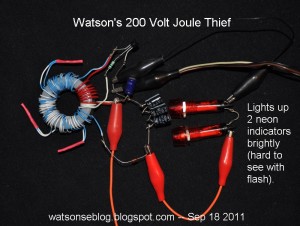My Watsonseblog dated 2011 Sep 18
2011 Sep 18 200 Volt Joule Thief
This turned out to be easier than I thought, since I was messing around with some serious voltages. It didn’t take long to wind the core, and I used some scraps of wire (you can see the splices I covered with red shrink tubing).
The core
I used a rather large 36mm or 1.4 inch OD core, and wound seven turns of red wire for the primary and three turns of white wire for the feedback windings (see picture). The core is high permeability and the primary winding was about 400 microhenrys. Starting at the collector end of the red winding, I connected some more 24 AWG insulated telephone wire and wound another 46 turns, splicing the wire as I went. Since the cold end of the high voltage winding is connected to the collector, the ratio of the windings is about 8 to 1.
I used a BAV21 high voltage diode to rectify the hot end of the winding, and I connected three 10 uF, 63VDC caps in series for an effective capacitance of 3.3 uF at 189VDC.
The joule thief part is the PN2222A transistor‘s collector connected to the red winding and the base connected to the white feedback winding through the 1k resistor. I put a 47 uF capacitor across the power supply leads.
Operation
After I got it together I connected the DC meter across the three caps and touched the 1.5VDC power supply leads briefly to the plus and minus, and the meter shot up to way over a hundred volts. Wow, I knew then I had to put a load across the three caps. I got the spiral part of a CFL and connected it across the three caps. I connected the power supply up, and I watched the meter zoom to over 200 volts, but the CFL refused to light up. Whew, the voltage was too high, the 3 poor capacitors were getting more than 70 volts apiece.
I removed the CFL and connected two neon panel indicators in series across the 3 capacitors. I reconnected the power supply and the voltage across the 3 caps and indicators stabilized at 136 volts and the neons lit up brightly. The 1.5V supply was at 55 milliamps and the frequency was 23 kHz. I’m disappointed that the CFL wouldn’t light up, and I may have to add more turns to see if I can get it to light.
Back to experimenting…











